
Captain (Louis) Ferdinand Ferber (1862- 1909)
Perhaps best described as an important failure, Ferber was born in Lyon and entered the Ecole Polytechnique in 1882. He joined the Army and rose through the military ranks as an artillery officer, eventually commanding the Alpine Artillery Battery at Nice. Ferber began emulating Lilienthal's (qv) experiments in 1899. His approach was often haphazard and his machines were poorly made.
Ferber's importance is due to the example he set for other Europeans, particularly French experimenters. He continued to experiment when most others had given up. He introduced Chanute to French aviation circles and Chanute made them familiar with the Wright brothers' work. Ferber influenced Archdeacon (qv), Voisin (qv) and thus the entire French aviation community. Although he never built a successful plane by himself, he did aid somewhat in the design of the Antoinette. During 1909 he competed at Rheims under the pseudonym 'de rue'. He won several minor competitions but on 19 September 1909 lost his life in a crash at Boulogne.
A History of Aeronautics Ferber, for instance, has left little from which to state what he did, and that little is scattered through various periodicals, scrappily enough. A French army officer, Captain Ferber was experimenting with monoplane and biplane gliders at the beginning of the century-his work was contemporary with that of the Wrights. He corresponded both with Chanute and with the Wrights, and in the end he was commissioned by the French Ministry of War to undertake the journey to America in order to negotiate with the Wright Brothers concerning French rights in the patents they had acquired, and to study their work at first hand. Ferber's experiments in gliding began in 1899 at the Military School at Fountainebleau, with a canvas glider of some 80 square feet supporting surface, and weighing 65 lbs. Two years later he constructed a larger and more satisfactory machine, with which he made numerous excellent glides. Later, he constructed an apparatus which suspended a plane from a long arm which swung on a tower, in order that experiments might be carried out without risk to the experimenter, and it was not until 1905 that he attempted power-driven free flight. He took up the Voisin design of biplane for his power-driven flights, and virtually devoted all his energies to the study of aeronautics. His book, Aviation, its Dawn and Development, is a work of scientific value--unlike many of his contemporaries, Ferber brought to the study of the problems of flight a trained mind, and he was concerned equally with the theoretical problems of aeronautics and the practical aspects of the subject. After Bleriot's successful cross-Channel flight, it was proposed to offer a prize of L1,000 for the feat which C. S. Rolls subsequently accomplished (starting from the English side of the Channel), a flight from Boulogne to Dover and back; in place of this, however, an aviation week at Boulogne was organised, but, although numerous aviators were invited to compete, the condition of the flying grounds was such that no competitions took place. Ferber was virtually the only one to do any flying at Boulogne, and at the outset he had his first accident; after what was for those days a good flight, he made a series of circles with his machine, when it suddenly struck the ground, being partially wrecked. Repairs were carried out, and Ferber resumed his exhibition flights, carrying on up to Wednesday, September 22nd, 1909. On that day he remained in the air for half an hour, and, as he was about to land, the machine struck a mound of earth and overturned, pinning Ferber under the weight of the motor. After being extricated, Ferber seemed to show little concern at the accident, but in a few minutes he complained of great pain, when he was conveyed to the ambulance shed on the ground. 'I was foolish,' he told those who were with him there. 'I was flying too low. It was my own fault and it will be a severe lesson to me. I wanted to turn round, and was only five metres from the ground.' A little after this, he got up from the couch on which he had been placed, and almost immediately collapsed, dying five minutes later. and continues...
Part II - 1903-1920: Progress in Design, I Before proceeding to the next stage of progress mention should be made of the experimental work of Captain Ferber in France. This officer carried out a large number of experiments with gliders contemporarily with the Wrights, adopting--like them--the Chanute biplane principle. He adopted the front elevator from the Wrights, but immediately went a step farther by also fitting a fixed tail in rear, which did not become a feature of the Wright machine until some seven or eight years later. He built and appeared to have flown a machine fitted with a motor in 1905, and was commissioned to go to America by the French War Office on a secret mission to the Wrights. Unfortunately, no complete account of his experiments appears to exist, though it can be said that his work was at least as important as that of any of the other pioneers mentioned.
Captain Ferdinand Ferber Following collaboration with Chanute by correspondence, Ferdinand Ferber shifted his flight experents from his lilienthal inspired 'birdwing' style aeroplanes to the more traditional biplane design, but introduced birdlike transverse curves into his wing design. The machine was a tractor with triangular vertical fins at the lower extremities of the outer rear struts, adjustable, to serve in lieu of rudder. The elevator was forward on outriggers. The horizontal stabilizer was aft on outriggers with a fixed vertical skid panel. It was powerd by an Antoinette 50 h.p. engine. The machine was flown in August by Legagneux for 256m., winning the third prize of the A.C.F. for 200m. Ferbers known flights in his Aeroplane No.IX (9) July 22, 1908 : At Brest, Ferber flew 10, 30, 50 and 120m. July 25, 1908 : Flew 300m. Sept 05, 1908 : Flew for 2 mins., and on the 19th, flew for 230m. Sept 19, 1908 : Flew 500m. The machine was renamed the Antoinette III. June 13, 1909 : At Juvisy in a Voisin, Ferber flew 5 km. in 5 mins. and 30s. Sept 15, 1909 : At Boulogne, Ferber covered 9.65 km. in 9 mins. in a cross-country flight. Sept 22, 1909 : At Boulogne, Ferber was killed when his machine overturned in rolling into a ditch preparatory to attempting a cross-channel flight.
Captain Ferber
Extrait de la revue L'Illustration Officier de haute valeur, ancien professeur à l'Ecole d'application de Fontainebleau, le capitaine Ferber (né à. Lyon le 8 février 1862) peut être considéré comme le véritable précurseur de l'aviation en France. A une époque où les expériences des hommes volants provoquaient la risée générale, il s'intéressa passionnément aux tentatives de Lilienthal, et, le 30 septembre 1899, sur un planeur de 8 mètres de surface, il se lançait d'un sommet des environs de Genève. Deux ans plus tard, seulement, aux environs de Nice, il réussissait un premier vol plané de 25 mètres. Dès lors, il construit et expérimente une série d'appareils qui lui permettent d'établir des chiffres et de dégager quelques principes dont s'inspireront bientôt tous les pionniers de l'aviation. Un des plus curieux parmi ces appareils fut « l'automobile à hélices », grand châssis monté sur quatre roues, qui était propulsé par deux hélices aériennes. Entre temps, il faisait partie de la commission officielle envoyée à Dayton pour s'aboucher avec les frères Wright. Mais, réduit à ses seules ressources, ne pouvant obtenir aucun crédit du ministère de la Guerre, il se laissa devancer par M. Santos-Dumont. Il n'en conçut d'ailleurs aucune amertume. Après avoir essayé divers aéroplanes de son invention, il avait adopté le type actuel de biplan à queue. Connaissant à fond la théorie de son appareil, manoeuvrant parfois avec une certaine aisance. il étonnait ses amis par l'irrégularité des résultats obtenus. Il était pourtant d'une grande vigueur physique et sa prudence, peut-être plus raisonnée qu'instinctive, semblait propre à le garer de tout accident, grave. Il ne montait jamais en aéroplane sans avoir d'énormes genouillères en cuir et un casque comme ceux que portent les motocyclistes. Il prit part cette année au meeting de Vichy, puis à celui de Reims où il ne réussit à voler que le dernier Jour. Il avait concouru à Juvisy, pour des prix de peu d'importance, et dans la dernière semaine, il avait réalisé, à Douai, quelques jolies performances, les plus belles peut-être de sa carrière d'aviateur. Aimable et spirituel, d'une simplicité avenante, le capitaine Ferber s'était fait une place à part, dans le monde de l'aviation où l'on appréciait autant la distinction de ses manières que la souplesse de son esprit et l'étendue de son érudition.
Captain Ferber L'historique de l'aèroport de Nice trouve ses racines gr,ce # un de ces pionniers, le Capitaine Ferber. Ce militaire, alors ,gè de 39 ans , pour s'èvader de la grisaille de sa caserne, rÍvait de s'envoler pour gagner de grands espaces. Dës 1901 il inventa un planeur, puis un deuxiëme avec lequel il fera un bond de 50 mëtres # Beuil. Mais il lui faut attendre 1903 pour èquiper son planeur d'un moteur. Pour ce premier essai il a accrochè sa machine volante # une " grue " qui tournait comme un vèritable manëge. FERBER s'èteindra 6 ans plus tard dans un crash # Boulogne-sur-Mer. A cette èpoque les terrains qui bordaient la mer ètaient rèservès aux militaires et plus loin du rivage se trouvait l'hippodrome de Nice. Dës lors Nice va dècider de participer au dèveloppement de l'aviation en organisant un meeting aèrien en Avril 1910.
 Nice, April (Avril), 1910
Ce fut un succës extraordinaire : 100.000 spectateurs venus de partout et rèunis 15 jours durant sur le terrain de la Californie pour cèlèbrer l'aviation. Celle-ci en ètait # ses balbutiements. Mais l'enthousiasme animait dèj# les esprits qui avaient encore en mèmoire l'exploit de Louis BLERIOT traversant la Manche un an auparavant. Les responsables publics et les entreprises locales voulaient saisir cette opportunitè pour marquer Nice de cette passion aèrienne. Pour cela ils n'avaient pas hèsitè # investir des sommes colossales. L'attraction de la Riviera avait fait le reste. Le lancement de la crèation de l'aèroport ètait donnè : il ne s'agissait alors que d'un grand champ ou avaient ètè construits quelques hangars. Malheureusement un mois avant le dèbut du meeting ceux-ci s'effondrërent, la fragilitè du terrain ètant mise en cause. Cette euphorie s'arrÍtera au commencement de la premiëre guerre mondiale.
Gallery Assembled as best known in a timeline format
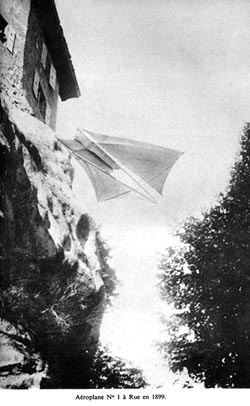 Ferber 'Aéroplane' No.1, 1899 Download a 500pixel image
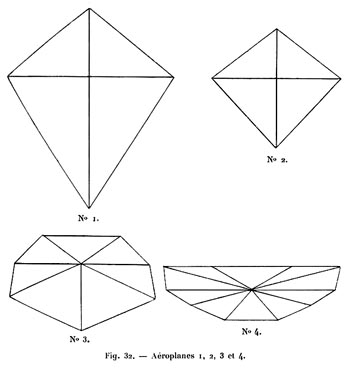 Ferber 'Aéroplanes' Nos.1-4 concepts
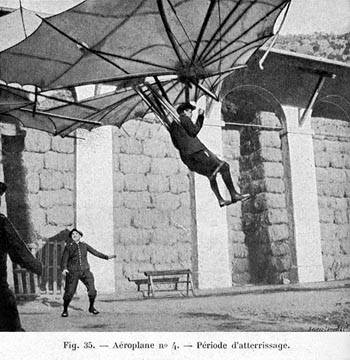 Ferber 'Aéroplane' No.4, 1901
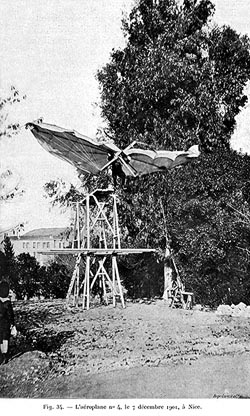 Ferber 'Aéroplane' No.4, 1901 Download a 500pixel image
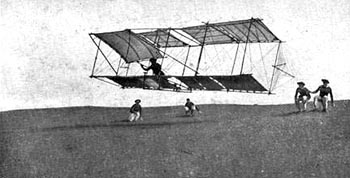 Ferber 'Aéroplane' No.5, 1902
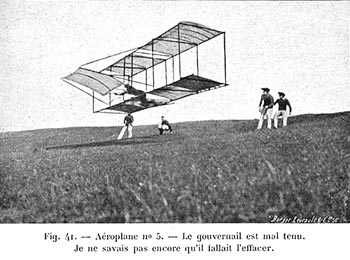 Ferber 'Aéroplane' No.5, 1902
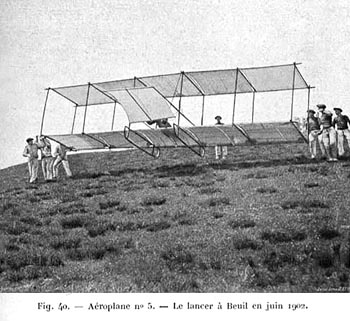 Ferber 'Aéroplane' No.5, 1902
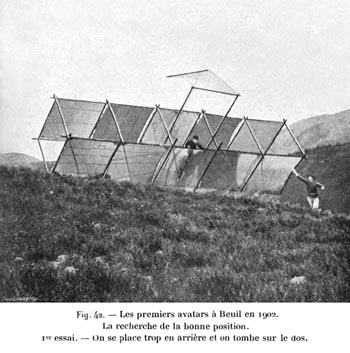 Ferber 'Aéroplane' No.5, 1902
1_350.jpg) Ferber Aéroplane No.6 Actually No.5 bis (Buchet 6hp motor) Download a 1000pixel image
2_350.jpg) Ferber Aéroplane No.6 Actually No. 5 bis (Buchet 6hp motor) Download a 750pixel image
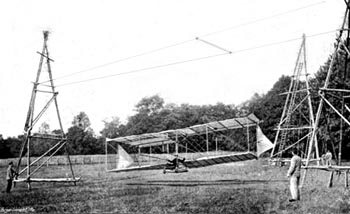 Ferber 'Aéroplane' No.6 Aerobscure
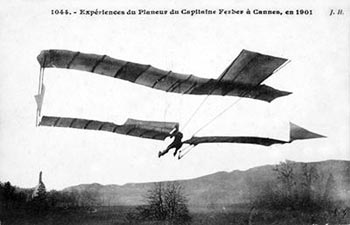 Ferber 'Aéroplane' No.6, Cannes, 1901
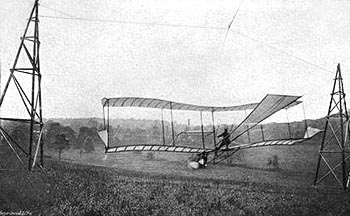 Ferber 'Aéroplane' No.6 Aerobscure
Type
without tail unit, 5 Most likely photographed at...
type 5, 5bis, Nice
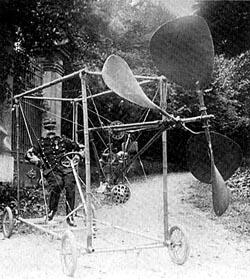 Ferber's propeller test rig credit Download a 500pixel image
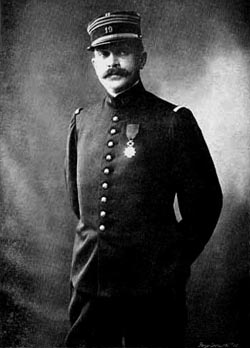 Ferber, 1908
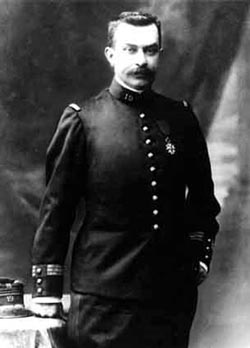 Ferber, 1908
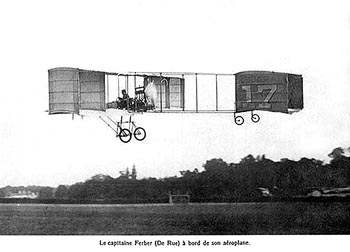 Ferber flies his Voisin No.17, c.1909 credit Download a 750pixel image
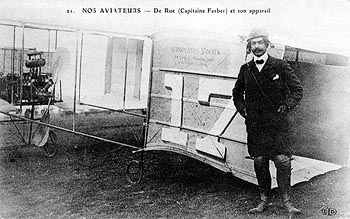 Ferber and his Voisin No.17, c.1909 Download a 1000pixel image
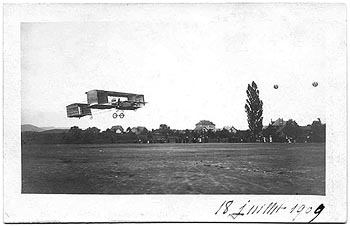 Ferber flies his Voisin, Douai, July 18, 1909 Download a 1000pixel image
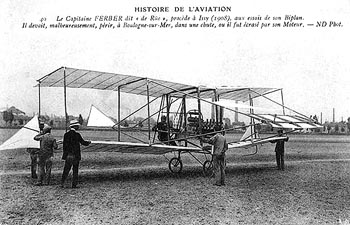 Ferber, Aéroplane No. 9 Download a 1000pixel image
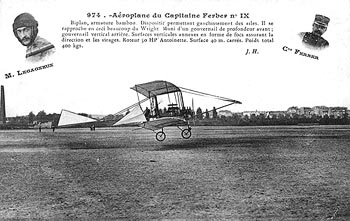 Ferber, Aéroplane No. 9 Download a 1000pixel image
 Ferber, Aéroplane No. 9 Download a 750pixel image
Les Travaux du Capitaine Ferdinand Ferber Pegase, La Revue de l'Association des Amis du Mus&eactute;e de l'Air Click on page to download a 1000pixel image [approx 300kb]
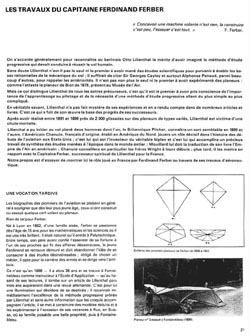 p.1 of 5
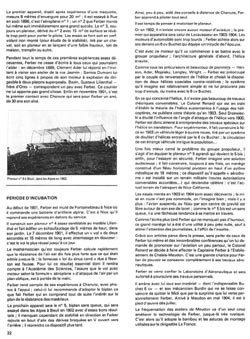 p.2 of 5
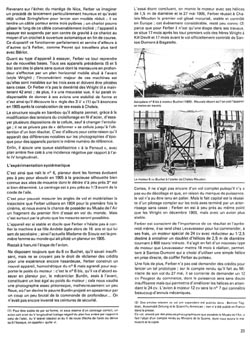 p.3 of 5
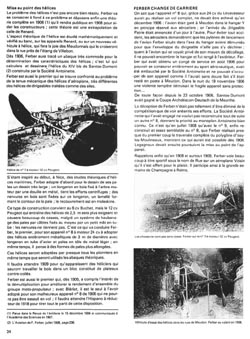 p.4 of 5
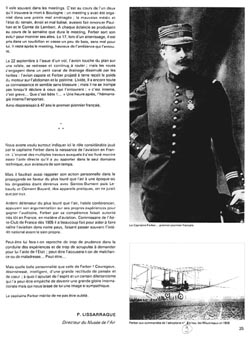 p.5 of 5
|
© Copyright 1999-2002 CTIE - All Rights Reserved - Caution |
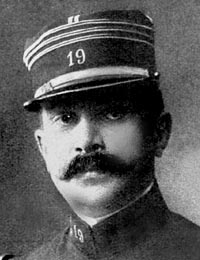 Ferber, Captain Ferdinand
Ferber, Captain Ferdinand